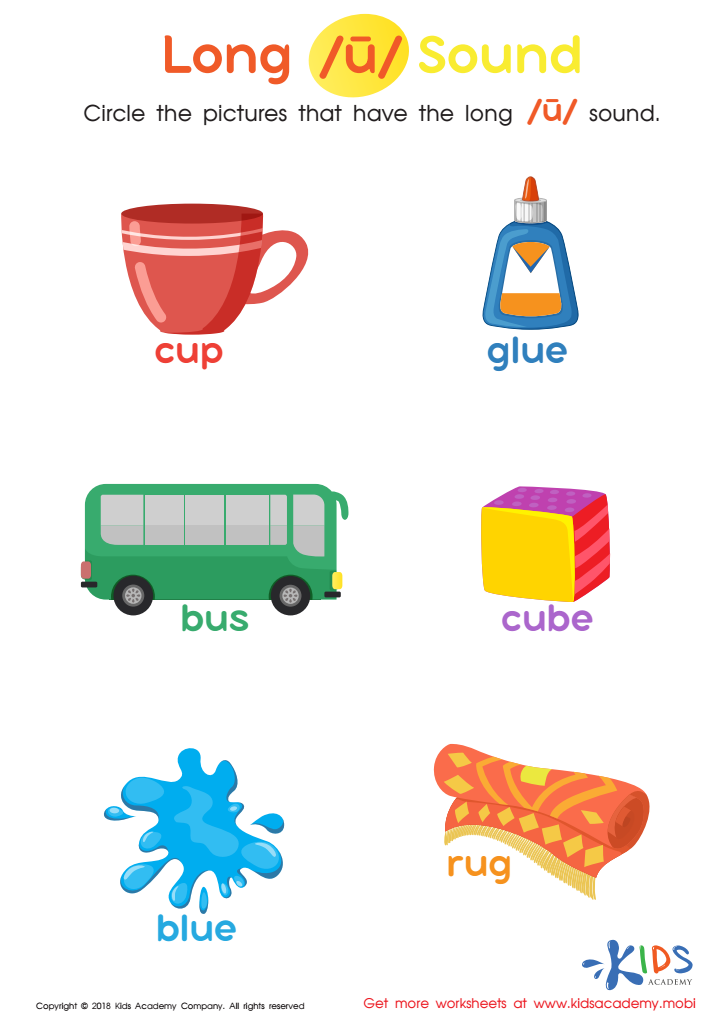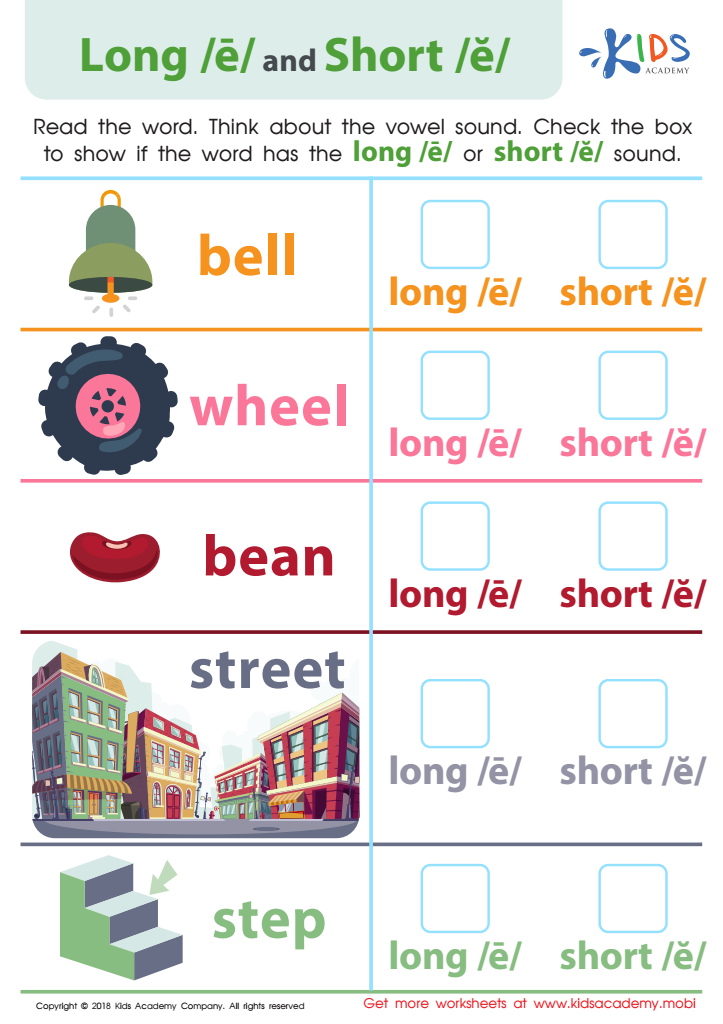
Phonics Essential Activities for Grade 2
Videos
(1/2)
Sorting Long and Short Vowels
Vowels mark the beginning of learning different words in pre-primary and primary classes. Kids should be taught these with utter vitality since they are one of the pillars of creating the foundation of English grammar.
In most cases, all the five vowels are spoken the same way, having the same sound; a, e, i, o, u. They all require the same tongue movement. But in this video, you will learn about long and short vowels and how to differentiate between the two.
There are total of 6 types of syllables out there and if you are about to start teaching your little one about syllables then we’d recommend you to start with the open syllables and the closed syllables.It’s just that these are easier to understand and your kid will learn quite fast. Not only this, in fact, after learning these two types, your kid will be able to speak a hundred different words.For starters, you need to tell your children what is a syllable. It basically is a unit of pronunciation that comes with a single vowel only. For more details, you can refer to the internet and watch videos on Youtube that tell everything you need to know about a syllable.
Worksheets
(1/21)
Ar and Or Words Phonics Worksheet

When reading, ar words and or words look almost the same, but sound very different!
Let’s master these distinct digraphs using this fun ar and or words phonics worksheet from Kids Academy! This easy-to-understand worksheet will guide your child to choose the correct digraph using colorful, yet meaningful illustrations.

What’s more fun for little learners than coloring? Coloring words they can read! This fun worksheet will give emerging readers opportunity to practice with words from the -aw word family, and help build their confidence in reading while they also work on fine-motor skills and creativity as they color. They won’t even realize they’re learning about phonetic teams as they have so much fun!

As your students advance in their education and learn more about reading and pronouncing words, they will see how some word patterns can be said in different ways. For example, the pattern ‘ough’ can be pronounced many different ways. In some words, it makes the sound ‘uff’ as seen in ‘enough’. Give your kids some more examples of common words that are pronounced similarly. Look through this worksheet with your students, and help them unscramble the ‘ough’ words. They should check the box next to the correct word.

Build your child’s vocabulary while practicing the diphthong ew using this ew words worksheet, that challenges kids to choose between lookalike words!
Filled with joyful illustrations, your child will enjoy completing this tricky worksheet, all while building important reading and spelling skills along the way!

At the end of this worksheet, your kids should be much better skilled at identifying objects correctly, and also better at counting syllables in words. Together with your little ones, look at the pictures in the printout. Help them to say each word out loud. Then, ask them to count the number of syllables they hear in each word. Help them tick the box that shows the correct number of syllables each word has.

This fun worksheet with engaging pictures will help your new readers strengthen their phonics skills as they learn to differentiate between long «ī» and short «i» sounds in one- and two-syllable words. They'll use picture clues to read the words and then check off the pictures that have the appropriate sounds in this free printout, and they'll find independent success in early reading skills.

Time to teach your class about long and short vowels? Look no further. This free, downloadable worksheet uses coloring-in to help your students understand the difference between long and short «As». First get them to read the words «cat» and «cake» one after another, so that they can hear the difference between the long and short «A sounds. Then let the children color in the words and the pictures. This creative printout will make any lesson on phonics an enjoyable one.

Teach your students the difference between long and short «Is with this fun coloring-in exercise! Print the downloadable worksheet and hand it out in your class, then get the children to read the words «pig» and «fire». Can they hear the difference between the long «I» and the short «I»? Understanding the difference between long and short vowels is vital when learning how to read, and this printout is the perfect tool for introducing this topic to your students. Get them to color in the words and the pictures to deliver a fun lesson on phonics!

Liven up your next lesson on long and short vowels with this entertaining printout! This worksheet uses reading, listening and coloring-in to teach your students the difference between long and short «Us». First, get the children to read the words «tube» and «tub» one after the other, making sure they hear the different «U» sounds. Then reinforce what you have taught them by letting them color in the words and matching pictures. This is a great tool for injecting a bit of fun into your phonics class.

Teach your students all about the long «E» sound with this fun coloring worksheet! Divide your class into teams, then get them to read words like «meet» and «team» while the rest of the class listens. They will hear the long E sounds and realize that it can be made by both the «ee» and «ea» pairings of letters. Finally, let your teams of children color-in the words and pictures, placing special emphasis on letters of the alphabet which make the long «E» sounds. A simple yet effective way to liven up your next phonics lesson.

Your child will find the bright and cheery pictures in this free PDF worksheet fun and engaging, and they'll practice differentiating between words with the long and short «u» sounds. They'll strengthen fine motor skills tracing circles around the appropriate words, and they'll learn to notice patterns (silent -e to make the «ū» sound) in closed-syllable words. It's a quick confidence builder for new readers!

Help students remember that the letters au and aw can make the same sound with this digraph worksheet. Children read a sentence and pick the correct word to complete the sentence. Each answer choice has the digraph /au/ or /aw/. Students that understand digraphs decode words more easily and are more fluent readers. Save this printable for your reading and phonics classes.

Find out if students comprehend syllables with this fun worksheet. Being able to break a word into its parts is a valuable decoding skill. This printable reminds students that a syllable is a word part that has a vowel sound. Then, children read each word and choose the number of parts in the words. Extra practice with this skill produces more confidence in decoding and reading new words!

Understanding that the long E vowel sound has different spellings is difficult for many young readers. The /ee/ and /ea/ make the same sound. Students need practice to know which vowel team is used when spelling words. This worksheet gives students practice with identifying the correct spelling for words with the vowel teams /ee/ and /ea/. Clear up confusion and improve reading and spelling with this printable.

If your class needs more practice counting syllables, then this worksheet is for you. Students read each of the words and count the word’s parts. The students circle only the words that have only one syllable. Students that master this skill easily decode unknown words and this improves fluency scores and comprehension. Clear up any confusion with this printout!

Telling the difference between the long A sound and the short A sound is challenging. Teachers need to provide practice opportunities for students so that they can master this phonics skill. This worksheet requires the student to look at a picture and identify if the name of the picture has a short or long sound of A. The student then chooses another word with the same vowel sound. Picture clues assist the student in reading the word. Children obtain mastery of the long and short sound of A with this printable.

End any confusion your students have when identifying the long E and short E sound by using this worksheet in your reading and phonics classes. Students look at a picture and read the word that is given. Students decide if the word has the long E or the short E sound. Learning vowel sounds is challenging to many learners, and this worksheet gives valuable practice for your students.

Students get plenty of practice sounding out short O and long O with this reading worksheet. Distinguishing between long and short sounds is sometimes confusing, so give your class this printable to improve their understanding of this skill. Students will sound out each word on the page and then circle the pictures with the long O sound. The worksheet is great for individual practice or for students to work with peers!

Decoding words is easier when students understand digraphs. A digraph is two letters that have only one sound. In this worksheet, students look at a picture and then complete the spelling for each word. The worksheet focuses on words with the /oa/ and /ow/ spellings. Use this printable in your reading classroom as well as for spelling practice. This worksheet is ideal for young and emergent readers.

When learning phonetics and the different phonetic sounds, your kids might find the entire thing a little confusing. First, they would need to learn and understand all the different sounds, and understand the short and long sounds as well. When it comes to vowel sounds, some sound alike. For example, the vowel digraph ou makes the same sound as the letters ow, as in cow. Read the words in this worksheet aloud to your students, and then help them check off the box next to the spelling of the word which matches the picture.

The diphthongs OI and OY sound exactly the same, but are spelled differently, making reading and spelling challenging for early learners! This vowel diphthongs oi oy worksheet will review these tricky spellings for quick and easy learning!
Guide your child through the worksheet to acquaint him or her with common oi and oy words!
Quizzes
(1/1)
One-Syllable Long and Short Vowel Words

This quiz assesses students’ ability to recognize the difference between short vowel sounds and long vowel sounds in one syllable words.


